Our Community
In just a few short years, our community has grown to include over 50 families in 14 countries. Below, you’ll find some personal stories from a few of those families as well as a world map including regions where our members reside. Please enjoy this peek into our background, and reach out to us through the contact page if you’re interested in sharing your story as well! If you are a parent of someone with SHINE Syndrome or are a researcher involved with DLG4 Synaptopathy, please consider joining our private Facebook group.
SHINE Community Worldwide Map
Community Stories
Here are a few stories submitted from our community to give a little glimpse into the lives of those with SHINE syndrome. Click the headings to expand each section.
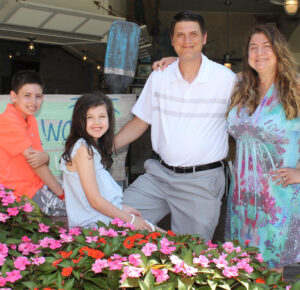 Updated 7-11-2022
Updated 7-11-2022
Emily is a loving verbal 10 year old. I knew within a few weeks that something was off with our precious little one. She seemed to have sensory issues right away. She couldn’t sit up on her own and was delayed in most areas. Early on we thought she was color blind because she could not learn her colors. She eventually learned her colors but was always behind her peers. She would learn something and then seem to forget it. She started PT and OT at age 2 for poor gross and fine motor skills. She couldn’t jump, but eventually learned to. She couldn’t dress herself, but also learned how. Still working on bathing independently. She was diagnosed with a mild intellectual disability and ADHD. She had an MRI, which showed nothing and Neurology and physical medicine said they didn’t need to see her back and referred us to behavioral. She has always slept good unlike many others in the community.
We opted for round two of genetic testing and the door opened. Everything suddenly made sense. She was diagnosed in 2019 with Shine Syndrome. Specifically, de nova dlg4 mutation, ESES, ID, dyspraxia, scoliosis, and hypotonia. The scoliosis would not have been picked up without my geneticist getting her checked due to what he read on the one available DLG4 paper. None of the previous doctors detected it. This process has taught be to be an advocate and push the system. The Facebook group made such an impact on our family. We requested she be tested for ESES and found her spikes were at 95%. With treatment, she is now at 12%. After starting the seizure medicine she learned to read and her reading scores continue to increase at an astounding rate. She is in general education and is pulled out for PT, OT, speech, and general intervention. Her math skills are at the 1st grade level and she struggles enormously with writing and drawing. She can type with one finger and is learning to spell better.
Emily does well socially and is blessed with kind children that help and treat her respectfully for the most part. SHINE impacts the whole family. Her older brother struggles with jealousy and sometimes tires of being helpful and understanding. She is unable to ride a bike but loves to swing and be outside. Her favorite things include dancing, watching movies, and playing with Barbies. After a recent trip to Disney World, I asked what her favorite part of the trip was. Her response? “Spending time with you guys.”. She is a ray of sunshine and only wants acceptance and inclusion. She struggles with her temper and throws screaming fits often. Mostly out of frustration when she can not find something or use something like a remote control properly. She has always hated using the restroom and had accidents through 2nd grade. She knows she is different but has confidence. She is able to calm herself out of frustration by taking deep breaths. At this point, I don’t think Emily will ever drive a car. Besides that, I think only time will tell what the future holds for her. She is relentlessly fierce. Even on her worst days she does not give up. She wipes the tears away and keeps trying. To date, she has not had a visible or reported seizure. She does mix things up often. Her concept of time has improved but still off. Meaning, she will refer to yesterday , when it was something that happened last week /month and vice versa. She chokes sometimes but has no dietary restrictions. She needs reminded to take smaller bites and slow down. She left her group during summer camp and jumped into the deep end of a pool. She can not swim and luckily the lifeguard got her. She typically doesn’t attempt to wonder off but she did also leave the house once without our knowledge. She knew this was unacceptable and unsafe. I am sharing this because both of the last incidents surprised me. I would never have thought she would do either but they happened. Both at age 9. She has a loving and supportive family. Most importantly she is generally a very happy girl. She loves her new puppy and was a bit rough with him at first but she has adapted just fine. She is extremely affectionate and caring and SHINES like the rest of this beautiful community. Mom has anxiety from navigating this special needs world. There has been lots of worrying whether I am pushing too hard or not hard enough, limiting activities too much or not enough, dreading seizures, prepping for an unknown future, etc. We look forward to continued support from the SHINE community. Blessings to all of you. Together we will make a difference.
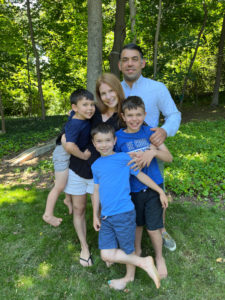 Updated 6-25-2022
Updated 6-25-2022
Noah is the oldest of the three little men in our family. For the first two years of life he seemed to meet developmental milestones, had an amazing vocabulary and was great at most everything. However, shortly after he turned three it was becoming apparent that certain things were not as they should be. Noah was evaluated and found to be significantly globally delayed though he had many splinter skills at that time which made him look quite typical in many ways. He started physical therapy, occupational therapy, speech language therapy, vision therapy and special education services. We also started our search for answers.
Just before Noah’s fifth birthday, he had his first EEG which revealed that he has an epileptic encephalopathy and that his brain was randomly discharging every 2-3 seconds during the day and even more at night. He was also having focal seizures which have since progressed from absence seizures only, to a combination of absence (staring episodes), atonic (drop seizures) gelastic (laughing) seizures and fear auras. Over the next two years Noah trialed several anti-epileptic drugs to mediate the abnormal brain activity with limited success. The medications have gotten control of some of his focal seizures and much of his brain’s daytime spiking. Unfortunately, the removal of the daytime spikes and focal seizures did not result in significantly improved cognitive functioning.
When Noah was seven, he suffered a huge regression of his cognitive abilities, language, motor control and behavior. At that time, he was diagnosed with Electrical Status Epilepticus in Slow wave sleep (ESES), a rare form of epilepsy characterized by neurocognitive regression, epilepsy and near continuous spiking during sleep. Since that time, he has been in and out of the hospital for testing and treatments with no real success. While searching for answers, Noah underwent a full exome sequencing which revealed Noah has the DLG4 mutation. The discovery led us to the other SHINE families. When we heard the traits associated with SHINE syndrome, we were surprised at how perfectly they describe Noah and the complications he faces in life.
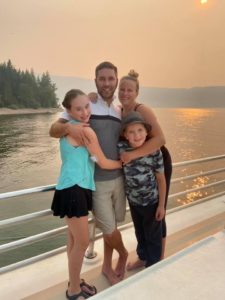 Updated 1-30-2022
Updated 1-30-2022
We were so excited to welcome our second child into our family. This meant our daughter was going to be a big sister and that she is. She loves her brother with such a special bond.
Izac was born May 2012. Our healthy baby boy officially arrived.
My pregnancy and his birth were fairly straight forward. Our boy was one hungry little man that seemed like we could never keep up between nursing him and bottle feeding. For 9-18 months of age there was a noticeable delay cognitively, fine/gross motor and his language.
We alway said that he was too busy eating to sleep. He doesn’t have a great track record for sleeping or crying. This was our hint, it really seemed odd to others that we were alarmed by those two things. Parents know best!
The door opened for us when we were referred to our pediatrician when Izac was 9 months old. This was the start of the medical appointments that lead to dead ends for a few years. Izac was coming into his second year birthday, it was decided that he needed to have an Autism assessment. The struggle for severe sleep disturbance to delayed motor skills, speech and possible ADHD, we needed more support for Izac. He was approved for a few supports, but it wasn’t enough.
Age 4 Izac’s assessment came back with a moderate Intellectual disability. This was not on our radar, it was a starting point. It was an opening to possibly more therapy, social play, family support. For the next year we tried to utilize everything we could before he went to kindergarten. It was always assessment after assessment with so much confusion on what would best suit Izac.
In between all the appointments with specialists and therapies we did lots of camping and quading. We decided Izac was going to learn to drive a quad. Izac was a passenger on our quad for years before he got his. Repetition, repetition, repetition is what brings Izac to driving his own quad to this day. He started when he was 4 years old, we had a pull cord so we could stop it at any time. My husband Mark, Izac’s amazing dad, his soul sister and I all took turns on the back of his quad guiding him through his first few years of learning to drive his quad.
That was a wild ride. At age 7, on my birthday, he showed us he could do it all on his own.
This is our milestone – we couldn’t be more proud.
Back to kindergarten 2017, he started school with a category which gave him some funding. He struggled with leaving me, he struggled with any academics, he was very observant when it came to what and how he needed to fit in with his peers. Izac has the most beautiful blue eyes that stare right through you and his smile talks a million words, and his education assistant and teachers alway loved having him around. The struggle was what and how does he learn. What exactly does an intellectual disability really mean to a kindergartener that had low fine/gross motor along with being years behind his actual age. It meant that we had to figure it out. We had some new additions on the team, his school team.
Let’s fast forward to 2018- The topic of conversation was “does Izac have absent Seizures”?
This was very interesting to us; we had the first 24 hour sleep seizure test. At this point it was only a suspicious thought. The difficult part was Izac didn’t sleep much to start with and staying asleep wasn’t much of an option. It came back that it was not anything to worry about. We didn’t close that door for good it just wasn’t the time.
In between all the avenues looking for answers we went back and ended up with a Autism diagnosis too. Finally we had something to help direct us. It just didn’t feel complete. I alway knew we weren’t at the end. Izac had more to share. I just couldn’t pinpoint it.
Two years later 2020, we decided that it needed to be looked at from a neurologist. We did another 24 hour sleep seizure test. The main concern this time was Izac would sleepwalk at night crying that he had to throw up or go to the bathroom. In the morning he didn’t remember any of it and he was never sick that day, just exhausted in the morning. Yes- there is such thing has seizures starting in your stomach. Moving on Izac’s 24 hr seizures test came back. He has two different Epilepsy’s : Rolandic Epilepsy, Focal Epilepsy.
A few of Izac’s favourite activities is swimming every day whether it is in the pool at our local rec center or in our hot tub or in the bathtub. He loves to be in water. Anything that has a motor he is driving it or wants to drive it. He thrives to be outside playing in the sandbox, jumping on the trampoline, swinging in the hammock, ice fishing, snowshoeing, skiing or shoveling the snow off the driveway. Izac has a kind gentle heart that cares more about everything and everyone in this world, more than he could every express.
We found out that Izac had the DLG4 mutation a year later. The connection to other families like ours is irreplaceable and enlightening to say the least. Thank you for never giving up and giving us hope for the future.
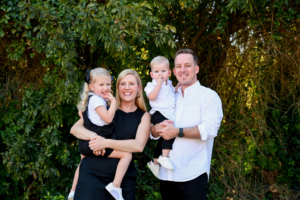 Updated 11-6-2021
Updated 11-6-2021
Harvey was born in March 2020, in Seattle, WA at the start of the Covid pandemic. When we came home with a healthy baby boy, we felt so fortunate. I had had an uncomplicated pregnancy and undergone all of the genetic testing available during pregnancy. We thought our worries were behind us. The next several months went by with little concern. The only presenting concern at birth for Harvey was intermittent strabismus, which his physician’s assumed he would grow out of overtime. By 5 months, though, we began seeing Harvey’s first specialist, the Ophthalmologist for worsening concerns over strabismus. Little did we know that this would begin our medical journey.
By 7 months old, we began having concerns over Harvey’s global lack of development. Fortunately we had a very proactive pediatrician, and by 8 months Harvey was referred to Seattle Children’s Neurology department. At 8 months old Harvey wasn’t rolling or beginning to crawl. He hated tummy time and had a difficult time holding his head up. He was also not grabbing or playing with objects as he had lost his initial grasp reflex, and we had noticed a tendency for Harvey to just whack at objects with his left hand. I remember working tirelessly with Harvey. Thinking, we’ll catch-up.
I’ll always remember his first Neurology appointment. It was two days before Christmas 2020, and the Neurologist believed Harvey was showing signs of a perinatal stroke. At this point, Harvey began undergoing several diagnostic tests (MRI, several rounds of metabolic testing, and ultimately two rounds of genetic testing), but the MRI and metabolic testing were not indicative of a perinatal stroke. After a family move across the country to Austin, TX in early January 2021, I remember the Neurologist reviewing his MRI and stating he had a beautiful and healthy looking brain except for some signs of delayed myelination, which he was not overly concerned by at the time. Despite Harvey’s brain looking great on a MRI, we would later learn through the research on DLG4, that his brain wasn’t working properly. I also remember one specialist saying Harvey was a ‘mystery.’ By 10 months of age, Harvey was diagnosed with a Cortical Visual Impairment (CVI), which his Ophthalmologist observed long before he received his DLG4 diagnosis, and he was given a prescription for glasses for the strabismus. At this point we were also referred to a slew of specialists and therapies: GI for constipation and possible food intolerances due to rash and days of inconsolable crying; Orthopedist for concerns about leg length discrepancy, hip dysplasia monitoring, and concerns over possible scoliosis; ENT for swallowing concerns; Audiologist to rule-out hearing concerns; OT for fine motor and sensory defensiveness and self-stimulatory behaviors such as rocking and staring at his hands; PT for ongoing gross motor delays; ST for speech/babbling delays as well as feeding therapy due to his lack of muscle control when swallowing; dietitian to better understand the inconsistencies in bloodwork and better control his diet with his limited eating abilities. It took until 17 months of age for us to get the results of the full Xome genetic testing. At that point we learned that Harvey had experienced a spontaneous genetic mutation of the DLG4 gene. All of a sudden, everything made sense, all of the delays, all of the confusion, all of the sleepless nights due to anxiety over Harvey’s needs and his uncontrollable crying. We finally had an answer.
We don’t really know what’s ahead for Harvey, as we await what life brings. There will be several more specialists, I’m sure, including ruling out any signs of seizures common with DLG4 and getting a gait trainer soon, and likely years and years of therapy. But, we do understand the power of one simple mutation and its devastating effects on a child and their family. Our sweet baby boy has the best giggles, especially when he sees his big sister, he now loves to pull my hair and headbutts me out of affection, but most days are a real struggle. Some days, he cries for no understandable reason, has no self-feeding skills, has limited mobility, and limited communication except for cries of frustration. His therapy, doctor’s appointments, and the ongoing fights with insurance can be exhausting. It’s also incredibly difficult finding a daycare, even special needs daycares, which would accept my son with the level of care he requires, so ultimately one caregiver often has to quit working in order to meet the needs of a child with DLG4. Despite all of this, he’s my baby boy. We still get to watch him grow and change, and he is slowly making progress. He now rolls, can sit independently, does some grunting for communication, and can bear weight when standing in his new foot braces and is starting to take steps with assistance.
My hope is that one day we’ll have more than answers, we’ll have solutions for other children and their families. I truly believe that the scientific progress in genetic therapy will one day be a solution for DLG4, which is why I’m here posting about my child, in hopes that another child and his/her family may not have to face the devastating consequences of a rare genetic disorder like DLG4. I hope that researchers will hear these stories and have the will and drive to find answers, and I hope we can find the financial donors to support such research. I hope, for me, for my family, for other families, but mostly, I have hope for my son.
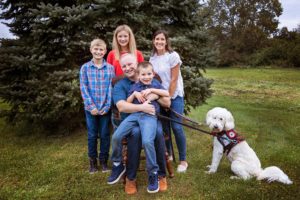 Updated 11-8-2021
Updated 11-8-2021
Meet Nolan! Nolan is the third child in our family. He seemed like he was developing fairly normally, however, by the time he was two, there was a more noticeable difference in his language and cognition when around same-age peers. We saw many doctors in various specialties and went through a battery of medical diagnostics and neuropsychological exams; during this time, we never got any formal diagnoses but did rule a lot of things out. We kept hearing “give him a few more months to develop” from physicians.
During this time, Nolan was enrolled in early intervention services through our county, as well as speech and occupational therapy at our local hospital. At the age of four, he had his first 24-hour EEG and was quickly diagnosed with epilepsy, specifically ESES; ESES (electrical status epilepticus during slow-wave sleep) is a rare epileptic encephalopathy that causes near-constant spikes while sleeping and negatively impacts neurodevelopment. We also discovered Nolan was having clinical seizures during sleep. Epilepsy has been the biggest struggle for our family, as Nolan’s seizures have been medication-resistant despite trying over 10 different anti-seizure medications, IVIG, the ketogenic diet, and a Vagus Nerve Stimulator. In October 2021, he was one of the youngest patients in the United States to have a Deep Brain Stimulator (DBS) implanted as an epilepsy treatment. Nolan was partnered with Nerys, his service dog in 2018 who is trained in seizure alert, tethering, tracking, and behavior disruption. In addition to epilepsy, Nolan also faces challenges with motor coordination, receptive and expressive language, and sleep.
We found out Nolan had a DLG4 mutation originally when he was four years old through an intellectual disability panel. At the time, it was labeled as unknown significance. Two years later, we found out that the gene was disease-causing. Connecting with other families who share our challenges has been amazing. When you have a child that is very rare, it helps to know there are other families going through similar difficulties, even if you’ve never met them in person!
Although Nolan faces many obstacles, he also brings a lot of joy to our lives. He loves Lego Star Wars, swimming, and swinging. He gives the best hugs and snuggles. He has also taught our family and friends so much about inclusion, acceptance, and what really matters in life. Thanks for learning about Nolan and our family!
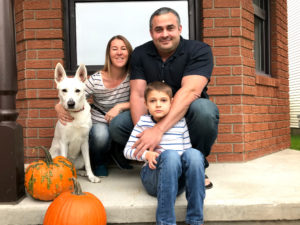 Updated 8-22-2022
Updated 8-22-2022
Here’s a bit about Cédric, or as we call him The Dude, and his journey (in Ontario, Canada).
Very early on, we noticed that Cédric was not reaching milestones at the same pace as his peers. By 18 months old, we were able to consult a developmental therapist, a physiotherapist and a speech and language pathologist. They confirmed delays in all areas and we started therapies and a quest for a diagnosis.
We first got, with difficulty, a diagnosis of developmental delay which allowed him to start school with the help of an Educational Assistant. We had to keep pushing and eventually got an autism diagnosis which opened doors to funds and services. This was our reality and our sense of Cédric’s identity for years, but we always felt he was still a special case within that group.
After he started having epileptic partial seizures at 9 years old, genetic testing was done and we received a DLG4 frameshift mutation diagnosis in November 2018, just before he turned 11. And this has felt like coming home, like finding him and his identity, as it medically explains all his challenges. It also allowed us to find our family in the small but mighty community of other families affected by DLG4 mutations.
In Cédric’s case, the mutation causes a severe intellectual disability, neurodiversity (autism) and epilepsy. He is very hyperactive, anxious, non verbal, not toilet trained, hypermobile and low tone, and had gastro- intestinal issues. And his epilepsy has been a difficult new challenge as his seizures are hard to control and are drop seizures (which paired with no sense of danger, bad motor control and hyperactvity is a bad combo).
With all that said, Cédric is a generally happy, pretty easy going and very affectionate guy who gives the best hugs and kisses. He loves anything sensory stimulating (car rides, swings, trampolines, roller coasters, music), especially water (swimming, showers, baths). Our happy place is definitely Disney World. And he is literally diagnosed in black and white as charming and handsome (by the psychiatrist on his autism diagnosis) which he uses to get away with quite a lot!